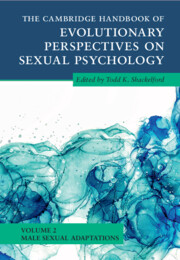Book contents
- The Cambridge Handbook of Evolutionary Perspectives on Sexual Psychology
- The Cambridge Handbook of Evolutionary Perspectives on Sexual Psychology
- Copyright page
- Contents
- Contributors
- Preface
- Part I Precopulatory Adaptations
- Part II Copulatory Adaptations
- 8 Sexual Fantasy
- 9 Ejaculation Latency
- 10 Copulatory Thrusting in Males
- 11 Men’s Provisioning of Oral Sex
- 12 Inducing Female Orgasm
- 13 Copulatory Urgency
- Part III Postcopulatory Adaptations
- Index
- References
12 - Inducing Female Orgasm
from Part II - Copulatory Adaptations
Published online by Cambridge University Press: 30 June 2022
- The Cambridge Handbook of Evolutionary Perspectives on Sexual Psychology
- The Cambridge Handbook of Evolutionary Perspectives on Sexual Psychology
- Copyright page
- Contents
- Contributors
- Preface
- Part I Precopulatory Adaptations
- Part II Copulatory Adaptations
- 8 Sexual Fantasy
- 9 Ejaculation Latency
- 10 Copulatory Thrusting in Males
- 11 Men’s Provisioning of Oral Sex
- 12 Inducing Female Orgasm
- 13 Copulatory Urgency
- Part III Postcopulatory Adaptations
- Index
- References
Summary
Compared to the male orgasm, the female orgasm is poorly understood in humans. There is continuing debate about whether female orgasm is an adaptation or if it is a byproduct of the male orgasm. Additionally, even among scholars who agree that the female orgasm does serve an adaptive function, there are multiple proposed hypotheses as to what that function could be and insufficient evidence to differentiate among them. There are also questions concerning whether these hypotheses are mutually exclusive. However, there is one feature related to the female orgasm that is much clearer from the research: male interest in inducing orgasm in their female partners. This chapter will address male interest in inducing female orgasm from the perspective of sperm competition theory. First, the importance of avoiding cuckoldry and the use of tactics to combat sperm competition (including inducing female orgasm) will be discussed. Next, there will be a brief review of hypotheses for the possible adaptive function of female orgasm, with special attention paid to hypotheses related to the quality of the male partner. The chapter will then discuss specific behaviors men use to induce orgasm in their female partners, as well as the relational contexts in which men are more versus less interested in inducing female orgasm. Then, men’s individual differences in terms of traits (e.g., warmth and sense of humor) will be discussed with regard to how they moderate both interest and success in inducing female orgasm. The chapter closes with suggestions for several future directions in this understudied area of research.
- Type
- Chapter
- Information
- Publisher: Cambridge University PressPrint publication year: 2022



